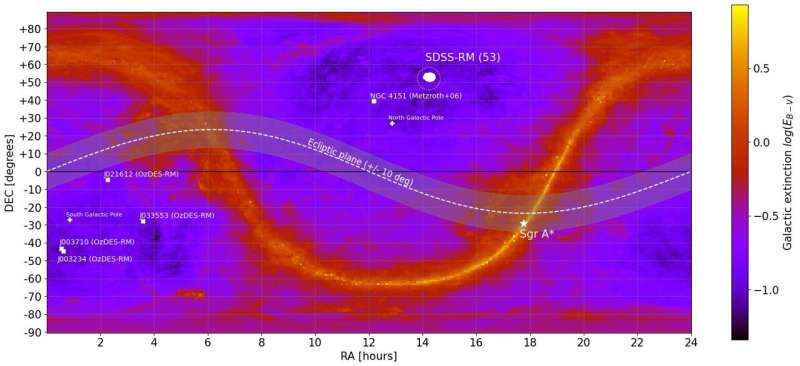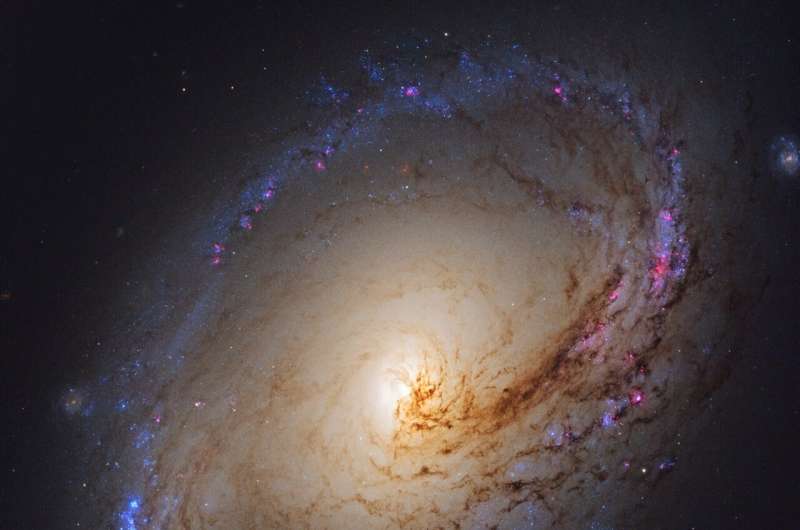February 8, 2024 dialog
This article has been reviewed according to Science X's editorial process and policies. Editors have highlighted the following attributes while ensuring the content's credibility:
fact-checked
peer-reviewed publication
trusted source
written by researcher(s)
proofread
Active galaxies as standard candles: Is dust the culprit behind discrepancies?

When did the universe start? When and how did the first stars and galaxies form? What is the fate of the universe?
The standard cosmological model, also known as the LCDM model, can answer most of these questions. It can also explain properties of the large-scale spatial structure of the universe—both in its current form as well as in the past, when the first structures were just emerging. Furthermore, via dark energy, it can address the accelerated expansion of the universe.
Despite many successes, over the last decade, nearby type Ia supernovae measurements and the analysis of distant cosmic-microwave background data have provided inconsistent values for some cosmological parameters.
In particular, there is a significant difference in the measured value of the current expansion rate, also known as the Hubble constant, between the value determined from the distant cosmic-microwave background measurements and some values determined from nearby type Ia supernova observations.
To determine whether this difference is due to systematic problems with one or both of the datasets or whether it is a problem with the LCDM model, alternate cosmological probes are sought.
My colleagues and I considered quasars as such alternative probes. These are active nuclei at the center of galaxies that host supermassive black holes accreting matter and profusely emit energy. They can be detected from the local universe to the distant epoch when the first galaxies were just forming. Therefore, they partially bridge local measurements of type Ia supernovae with distant cosmic microwave background observations.
Can quasars help resolve current cosmological tensions?
Two methods
It may seem strange that active galactic nuclei (AGN), which are rather complicated objects containing supermassive black holes, whose masses span five orders of magnitude (a factor of 100,000) and accrete matter over a wide range of rates, might be standardized in an analogous way to pulsating Cepheid stars or exploding (type Ia supernovae) stars.
Over the last three decades, as more and better-quality, multi-wavelength data were accumulated, AGN measurements were found to obey two important correlations, both of which involve ionizing electromagnetic radiation coming from the inner accretion flow around the central black hole in the ultraviolet part of the electromagnetic spectrum.
One of these is based on the correlation between the UV and the X-ray luminosities (UV/X-ray relation). In most AGN, the luminosities of radiation emitted in the ultraviolet and X-ray parts of the electromagnetic spectrum obey a nonlinear relation. Based on this, the luminosity distance of the quasar can be determined, and for a given redshift, the Hubble diagram of AGN can be confronted with different cosmological models.

The second one is based on the discovery that the luminosity of the ionizing UV radiation emitted near the central black hole is correlated with the radius of the more distant region where rapidly moving clouds orbit around the central black hole. The motion of these clouds is revealed through their characteristic emission in the form of very broad emission lines whose flux is variable.
From the measurement of the time delay between the variable UV radiation and the broad-line emission, it is possible to infer the absolute luminosity. From the measured flux, we can determine the luminosity distance and subsequently test cosmological models as well.
The question remains whether it is possible to find a sample of AGN for which both relations can be studied. This would allow for a consistency check of the determined luminosity distances and cosmological models (through their determined cosmological parameter values).
Discrepancy in luminosity distances
With my colleague Narayan Khadka from Stony Brook University (formerly at Kansas State University), we identified 58 such AGN and found that the two relations (UV/X-ray and radius-luminosity) led to quite different luminosity distances to each of the sources. This should not happen unless one or both of the datasets (UV/X-ray and radius-luminosity) did not properly account for some effects. Our study was published in Monthly Notices of the Royal Astronomical Society.
Moreover, the cosmological parameters obtained from these two relations were quite different, with the UV/X-ray relation preferring a larger matter content for the present-day universe in comparison with what the radius-luminosity relation favored. Additionally, the cosmological parameters values determined from the UV/X-ray relation measurements significantly differ from the values determined using standard cosmological probes. This left us with the puzzle of trying to discover the cause of the discrepancy.
Role of dust in galaxies
By comparing differences of the two luminosity distances to each of the 58 sources, it became apparent to us that the luminosity distance determined from the UV/X-ray relation is systematically larger than the luminosity distance inferred from the radius–luminosity relation. With Bozena Czerny (Center for Theoretical Physics PAS), I realized that such an effect can be caused by dust that absorbs and scatters UV as well as X-ray photons along the line of sight from the AGN to us.
Although the 58 observed quasars are located in regions of the sky away from the Milky Way dust clouds (see top figure), they are hosted in galaxies that contain numerous dust clouds through which the emitted photons must travel on their path to our telescopes.
In our recent study, published in The Astrophysical Journal, we showed explicitly that the extinction of the emitted photons due to dust always contributes to a non-zero difference between the two luminosity distances inferred from AGN correlations, being either positive or negative, depending on whether X-ray or UV photons are more affected. Since the distribution peaks are positive for all cosmological models, the extinction of X-ray emission from AGN appears to be more significant for most quasars than the extinction of UV light.
Conclusion
Dust in AGN host galaxies hinders mainly the applicability of the UV/X-ray relation in cosmology, while the radius–luminosity relation still appears viable for turning quasars into standard candles. Although the cosmological constraints from the radius–luminosity relation are still weak due to a limited sample size, the relation provides a silver lining for using quasars as cosmological probes, especially in the era of extensive sky surveys.
This story is part of Science X Dialog, where researchers can report findings from their published research articles. Visit this page for information about ScienceX Dialog and how to participate.
More information: Narayan Khadka et al, Quasar UV/X-ray relation luminosity distances are shorter than reverberation-measured radius–luminosity relation luminosity distances, Monthly Notices of the Royal Astronomical Society (2023). DOI: 10.1093/mnras/stad1040
Michal Zajaček et al, Effect of Extinction on Quasar Luminosity Distances Determined from UV and X-Ray Flux Measurements, The Astrophysical Journal (2024). DOI: 10.3847/1538-4357/ad11dc
Journal information: Astrophysical Journal , Monthly Notices of the Royal Astronomical Society
Dr. Michal Zajaček is a researcher at the Department of Theoretical Physics and Astrophysics, Masaryk University in Brno, Czech Republic. He defended his PhD thesis in 2017 at the University of Cologne/Max Planck Institute for Radioastronomy, Germany, on the galactic center, specifically concerning stellar dynamics, star formation, and the nature of infrared-excess objects. During 2017–2019 he was a postdoctoral researcher at the MPIfR in Bonn, working on jet precession in blazars, and during 2019–2021, he was an assistant professor at the Center for Theoretical Physics, Polish Academy of Sciences in Warsaw, where he studied the broad-line region of intermediate-redshift quasars and their application in cosmology.




















